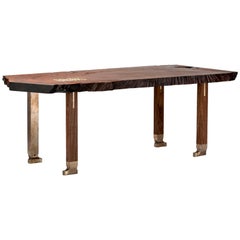Athol Desk
2010s American Organic Modern Desks and Writing Tables
Bronze
People Also Browsed
21st Century and Contemporary Croatian Brutalist Benches
Wood, Oak
20th Century Fountains
Art Glass
Antique 19th Century English Chinese Chippendale Vitrines
Glass, Mahogany
1990s Italian Modern Cabinets
Plastic, Wood
21st Century and Contemporary Modern Fountains
Cement
21st Century and Contemporary Portuguese Modern Ceramics
Ceramic, Clay
Vintage 1960s Italian Mid-Century Modern Dining Room Chairs
Iron
2010s American Cabinets
Brass, Steel
21st Century and Contemporary Modern Dining Room Tables
Marble, Brass
21st Century and Contemporary Modern Dry Bars
Leather, Stained Glass, Birdseye Maple
Vintage 1970s Fireplaces and Mantels
Ceramic, Majolica
20th Century Italian Other Fountains
Gold Leaf
Vintage 1980s Italian Dining Room Sets
Resin
2010s Dutch Western European Rugs
Wool
2010s Italian Modern Tapestries
Aluminum
2010s Spanish Post-Modern Benches
Upholstery, Beech
Taylor Donsker for sale on 1stDibs
The Taylor Donsker Furniture Company epitomizes exploration and imagination through its use of the forms, colors, grains and textures of wood. By complementing the dark luster of walnut with materials such as polished granite, each desk, bench and cabinet becomes a one-of-a-kind, handcrafted creation.
Taylor Donsker — the company’s founder — attended the University of Southern California (USC) for architecture. After graduation, not many firms were hiring, so in his spare time, Donsker explored woodworking and furniture design in his parents’ garage.
He eventually landed a job at an architecture firm, but found that the use of computers gave him a feeling of detachment. With woodworking and furniture design, he was able to feel connected to each project.
In 2012, Donsker presented his furniture at a design show and soon began receiving orders. The success led him to find inspiration in the trees themselves. In an interview with USC, Donsker said, “Now, I look at the roots of a redwood and see a chaise lounge, the stump of a eucalyptus tree that should be a throne.”
Donsker currently makes 10 to 15 large-scale pieces per year for an international clientele. Every wood is carefully considered for inclusion in a new furniture item, including its grain, texture and coloration.
On 1stDibs, explore Taylor Donsker’s seating, tables, storage pieces and more.
A Close Look at Organic-modern Furniture
Organic modern furniture is characterized by clean lines, an overall uncomplicated aesthetic and a prioritizing of natural, sustainable materials, such as wood and stone. There are lots of earth tones and natural-world textures rather than bright color palettes or fabrics embellished with busy patterns.
Organic furniture is minimalist and, owing to the ideas of venerable architect Frank Lloyd Wright, designed for warm spaces that promote harmony between human habitation and the great outdoors. Organic modern design, including in furniture and architecture, emerged in the 1930s.
Designers such as Andrianna Shamaris, Alguacil & Perkoff and Jörg Pietschmann — all known for organic modern design — have created furniture that brings dynamic and unpredictable energy to home interiors while emphasizing the importance of a relationship with the natural world.
Striking an appealing balance between our living spaces and nature doesn't have to be an arduous task — the broad selection of original organic modern furniture on 1stDibs includes solid wood tables, bamboo seating options, hand-knotted wall tapestries and more.
Finding the Right Desks-writing-tables for You
Choosing the perfect writing desk or writing table is a profoundly personal journey, one that people have been embarking upon for centuries.
Queen Atossa of Persia, from her writing table circa 500 B.C., is said to have been the originator of the art of handwritten letters. Hers was reportedly the first in a long and colorful history of penned correspondence that grew in popularity alongside literacy. The demand for suitable writing desks, which would serve the composer of the letters as well as ensure the comfort of the recipient naturally followed, and the design of these necessary furnishings has evolved throughout history.
Once people began to seek freedom from the outwardly ornate styles of the walnut and rosewood writing desks and drafting tables introduced in the name of Queen Victoria and King Louis XV, radical shifts occurred, such as those that materialized during the Art Nouveau period, when designers longed to produce furniture inspired by the natural world’s beauty. A prime example is the work of the famous late-19th-century Spanish architect Antoni Gaudí — his rolltop desk featured deep side drawers and was adorned with carved motifs that paid tribute to nature. Gaudí regularly combined structural precision with decorative elements, creating beautiful pieces of furniture in wood and metal.
Soon afterward, preferences for sleek, geometric, stylized forms in furniture that saw an emphasis on natural wood grains and traditional craftsmanship took hold. Today, Art Deco desks are still favored by designers who seek to infuse interiors with an air of luxury. One of the most prominent figures of the Art Deco movement was French decorator and furniture designer Émile-Jacques Ruhlmann. With his use of neoclassical motifs as well as expensive and exotic materials such as imported dark woods and inlays of precious metals for his writing desks, Ruhlmann came to symbolize good taste and modernity.
The rise in appreciation for Scandinavian modernism continues to influence the design of contemporary writing desks. It employs the “no fuss” or “less is more” approach to creating a tasteful, sophisticated space. Sweden’s master cabinetmaker Bruno Mathsson created gallery-worthy designs that are as functional as they are beautiful. Finnish architect Alvar Aalto never viewed himself as an artist, but, like Mathsson, his furniture designs reflected a fondness for organic materials and a humanistic approach. Danish designers such as Hans Wegner introduced elegant shapes and lines to mid-century desks and writing tables, often working in oak and solid teak.
From vintage desks to contemporary styles, 1stDibs offers a broad spectrum of choices for conducting all personal and business writing and reading activities.
